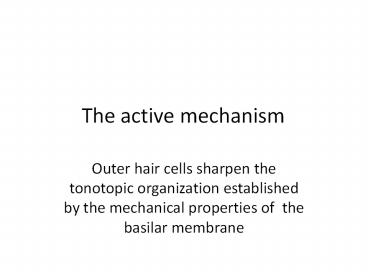The active mechanism - PowerPoint PPT Presentation
1 / 31
Title:
The active mechanism
Description:
Outer hair cells sharpen the tonotopic organization established by the mechanical properties of the basilar membrane One could construct a transfer function of each ... – PowerPoint PPT presentation
Number of Views:27
Avg rating:3.0/5.0
Title: The active mechanism
1
The active mechanism
- Outer hair cells sharpen the tonotopic
organization established by the mechanical
properties of the basilar membrane
2
The bottom line
- The mechanical properties of the basilar membrane
cannot account for the precise place-coding of
frequency in the auditory system. Another,
active, mechanism sharpens the mechanical
response of the basilar membrane.
3
An example of a transfer function is
D all of the above
4
Transfer function of a place on the basilar
membrane
From von Bekesy (1960), Gelfand (1998)
5
Tuning curve of a place on the basilar membrane
Level (dB) to produce X displacement
30 50 100 200
300 500
From von Bekesy (1960), Gelfand (1998)
Frequency (Hz)
6
This is the transfer function of a
A low-pass filter B high-pass filter C
bandpass filter D band reject filter
7
Which of these is the tuning curve of a bandpass
filter?
A
B
Sound amplitude (dB)
Frequency (Hz)
C
D
Sound amplitude (dB)
Frequency (Hz)
8
Which of these bandpass filters would give the
most precise estimate of the sound energy at 1000
Hz?
A
B
Sound amplitude (dB)
Sound amplitude (dB)
1000
1000
Frequency (Hz)
Frequency (Hz)
C
D
Sound amplitude (dB)
Sound amplitude (dB)
1000
1000
8
Frequency (Hz)
Frequency (Hz)
9
Tuning curves of auditory nerve fibers v. basilar
membrane
From Pickles (1988)
10
Healthy cochlea tuning curves
From Gelfand (1998)
11
Effects of death on tuning curves
From Gelfand (1998)
12
So whatever it is that makes tuning curves so
sharp
- Doesnt work in damaged cochleas, dead animals,
or at high intensities
13
Which of these describes von Bekesys experiments
on the basilar membrane?
- Observed basilar membrane motion in human
cadavers - Observations near the cochlear apex
- Used intense sounds to elicit responses big
enough to see under the light microscope - All of the above
13
14
So what are those outer hair cells doing there
anyway?
From Gelfand (1998)
15
Anatomical differences between inner and outer
hair cells
From Gelfand (1998)
16
Position of outer hair cells
From Gelfand (1998)
17
Damage to outer hair cells leads to broad tuning
From Dallos et al., 1977
18
OHC motility
From Holley (1996)
19
OHC motility
From http//btnrh.boystown.org/cel/ohc.htm
20
Outer hair cells move in response to sound.
21
Otoacoustic emissions
From Gelfand (1998)
22
Effect of OHC motility
http//147.162.36.50/cochlea/cochleapages/theory/c
ortimot/cortimot.htm
23
Effects of the active mechanism
From Pickles (1988)
24
Cochlear feedback loop
25
The tension in the tip link can be adjusted by a
motor
Text
26
The motor could also move the stereocilia bundle
- In nonmammalian hair cells, stereocilia bundles
vibrate at the stimulus frequency. - Mammalian hair cells at the base of the cochlea
have short stereocilia at the apex they have
long stereocilia. - Stereocilia bundle movements have been observed
in mammalian hair cells.
26
27
The active mechanism could be based on
- changes in the length of the OHC body
- movement of the stereocilia bundle on the OHC
- both of the above
27
28
The active mechanism
- improves hearing sensitivity
- improves the frequency selectivity of the
basilar membrane response - all of the above
28
29
Conclusions
- Outer hair cells function to sharpen the
displacement pattern of the basilar membrane. - OHCs also improve sensitivity to sound -- they
make response thresholds lower. - Motility of the hair cell body and/or the
stereocilia is one means by which OHCs accomplish
these functions.
30
Text sources
- Dallos, P. (1996) Overview Cochlear
neurobiology. In P. Dallos, A.N. Popper, and R.R.
Fay (Eds.) The cochlea. New York Springer. - Dallos, P, Ryan, A. Harris, D., McGee, T. and
Ozdamar, O. (1977) Cochlear frequency selectivity
in the presence of hair cell damage. In E.F.
Evans and J.P. Wilson (Eds.) Psychophysics and
physiology of hearing An international
symposium. New York Academic Press. - Gelfand, S.A. (1998) Hearing An introduction to
psychological and physiological acoustics. New
York Marcel Dekker. - Holley, M.C. (1996) Outer hair cell motility. In
P. Dallos, A.N. Popper, and R.R. Fay (Eds.) The
cochlea. New York Springer.
31
Text sources (continued)
- Pickles, J.O. (1988) An introduction to the
physiology of hearing. Berkeley Academic Press. - Yates, G.K. (1995) Cochlear structure and
function. In B.C.J. Moore (Ed.) Hearing. San
Diego Academic Press.































